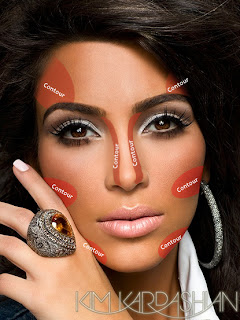I’d talk about the art of contouring. What is contouring you may ask? Contouring is essentially the opposite of highlighting. While highlighting is meant to accentuate features in your face, contouring is meant to minimize features by darkening areas. Contouring is a great way to make your face look thinner and more structured.
To contour, you can use a contour brush, sponge, or your own fingers. Then you would either need a bronzer, liquid or powder foundation, or I have heard some people use eye shadow. Whatever your choice, you must choose a shade only slightly darker than your skin tone; maybe only two or three shades darker. Any darker will make your contouring look unnatural. The usual areas to contour are on the sides of your nose, under your cheekbone, on the sides of your forehead, and under your neck, if necessary.
Darkening the sides of your nose makes your nose look thinner. Darkening under your cheekbones gives the appearance of hollowed cheeks, which makes your cheek bones look more prominent. Contouring the sides of your forehead makes your forehead look thinner, and darkening under your neck makes your neck look thinner as well.
When using liquid foundation, it would be best to use a sponge or finger tips. You would really need to blend the foundation into your face in the areas needed, so the areas look like they are in the shadow. If you use eye shadow or powder based foundation to contour, you should use a contouring brush. If you need help finding a good contouring brush, MAC #168 has great reviews. Since there are both liquid and powder kinds of bronzer, you should use either liquid or powder methods to apply the bronzer. Here are pictures of Kim Kardashian before and after her makeup routine, which happens to include both highlighting and contouring.
 |
| Before |
Contouring definitely takes a lot of practice, but with enough practice, your face will be ready for the cover of any magazine! I hope my tips helped, until next time!
 |
| After |



